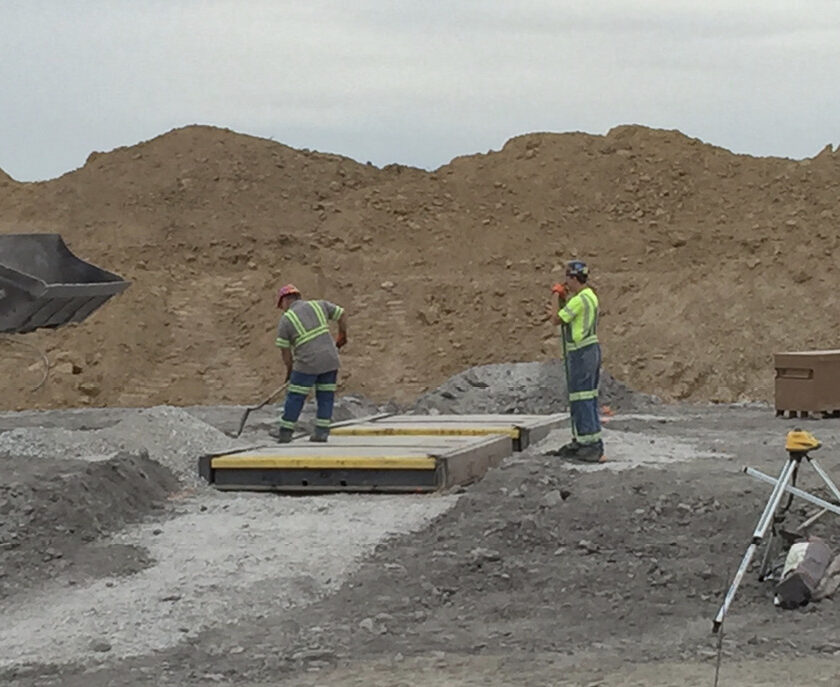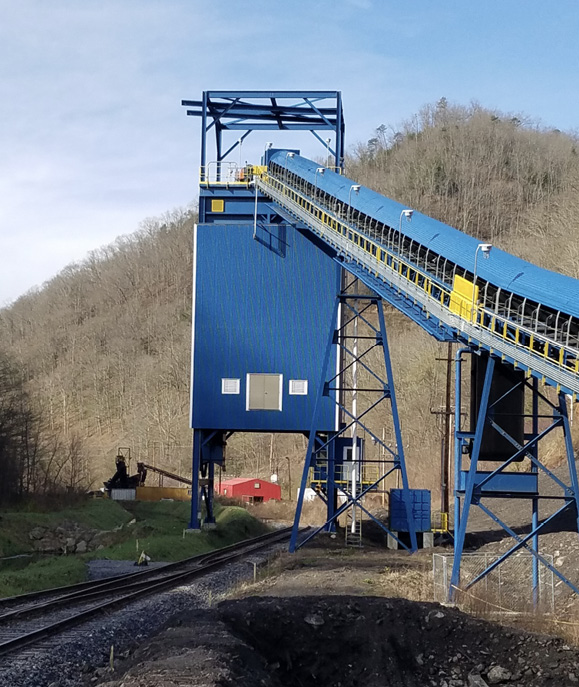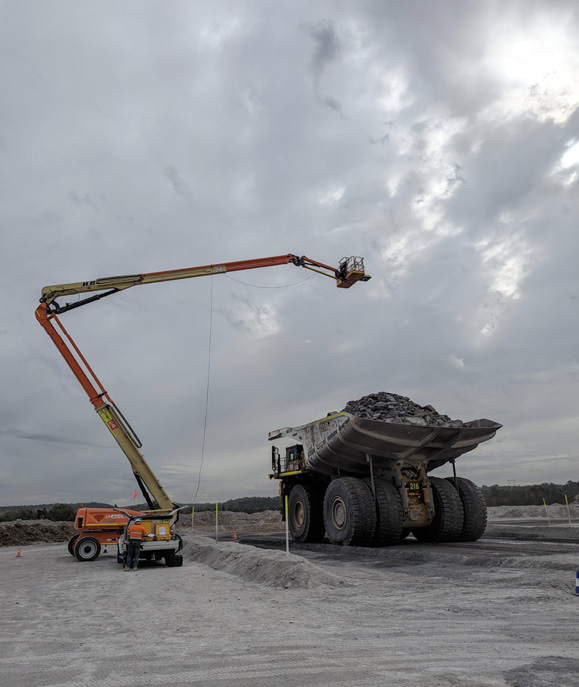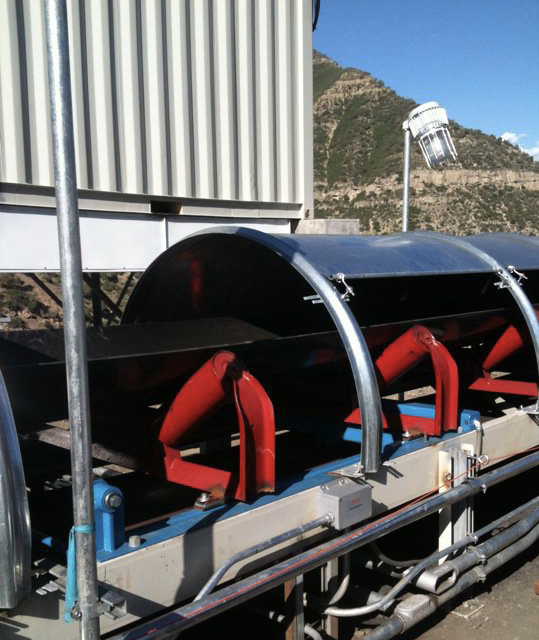You may not have considered your scales much – but you should. A roundtable of experts told North American Mining why these essential tools should not be taken for granted.
by Jonathan Rowland

Mining scales are indispensable tools in the mining industry. Designed to weigh large quantities of mined materials and built to withstand the intense vibrations, extreme temperature fluctuations and loads, moisture, and dusty conditions typical of mining operations, these scales fulfill various tasks, ensuring efficiency, quantifying production, maximizing movement and trade of product, and maintaining compliance with safety and environmental regulations.
So, just what is a mining scale?
“At the heart of every mining scale is a load cell,” explained Larry van den Berghe, president and CEO of Saskatoon, Canada-based Massload Technologies. “This load cell is typically a strain gauge-based sensor that converts mechanical force (weight) into an electrical signal, which is processed and translated into readable weight data.”
“Mining scales come in various shapes and forms, including truck, conveyor belt, rail, and loader scales, depending on the specific application within the mining process,” added Derek Schussele, technical sales at East Peoria, Ill.-based Walz Scale & Scanner, noting the fact that, throughout the mining process, material may be weighed multiple times. This was affirmed by Poca, W.Va.-based Kanawha Scale and Systems, who provided the following list of potential weigh points along the mining flowsheet.
During extraction and mine site haulage:
- Onboard weighing systems (installed on loaders, haul trucks, and excavators) ensure optimum loading and help avoid overloading.
- Truck scales or weighbridges weigh loaded and empty trucks to track the volume of extracted material.
- Rail scales are used when transporting ore via railcars from the mining site to processing facilities.
- Portable mining scales are deployed in remote or temporary mining operations to weigh materials on-site.
During mineral processing (crushing, grinding, and screening) operations:
- Conveyor belt scales monitor material flow on conveyor belts to ensure consistent production.
- Batch weighing systems help control ingredient proportions in mixing operations.
- Hopper and bin weighing systems measure the weight of crushed material before further refining.
During refining and further processing (milling and smelting):
- Batch weighing systems ensure the precise mixing of chemicals for refining.
- Tank and hopper scales measure liquids and solid materials used in ore refining.
- Precision scales verify final product weights before packaging or transport.
During dispatch and transportation:
- Truck scales (weighbridges) ensure vehicles are within legal weight limits.
- Rail scales verify weight compliance for train shipments.
- Port and ship loading scales weigh bulk mineral loads before export.
Mining scales are also used for inventory management and compliance:
- Stockpile weighing systems track the amount of mined material stored on-site.
- Legal-for-trade scales ensure accurate weight reporting for sales and taxation.
- Compliance weighing verifies loads against safety and transportation regulations.
“The versatility of mining scales makes them indispensable across various stages of the mining process, from extraction to transportation,” concluded Schussele.

Pictured: Kanawha Scale & Systems’ loadout.
Why weigh?
According to Schussele, the “primary benefit” of using mining scales is their ability to provide a certified, reliable foundation for measuring and analyzing material movement. “This certified baseline enables precise determination of haulage efficiency, offering insights into the performance of trucks, loaders, and other equipment at multiple material-handling points, such as extraction sites, processing plants, and stockpiles.”
Through on-site weighing, mining operations “can access many valuable insights and benefits,” agreed Stephen de Kock, managing director at Brisbane, Australia-based Eyemine. “These insights – or ‘Source of Truth’ as we refer to them – can relate to asset performance, production outlook, and commodity moved; they can also be embedded into maintenance. They allow for more informed decisions on equipment, production, and maintenance outcomes on mine sites.”
Ultimately, according to Kanawha Scale & Systems, the use of mining scales delivers the following:
- Improved accuracy and efficiency, such as onboard loader scales that facilitate truck loading to their maximum legal weight without exceeding limits.
- Increased safety and compliance, such as a mine using truck scales to ensure shipments comply with Department of Transportation regulations.
- Cost savings and waste reduction, such as a copper mining company using conveyor belt scales to prevent excessive loss by monitoring real-time material flow.
- Better inventory control and production management, such as a mine using belt scales to identify inefficiencies in material handling and prevent bottlenecks.
- Enhanced profitability, such as a mine using weighbridges to prevent fines from overweight trucks.
Mining scales are “critical operational tools, not just accessories,” concluded Massload Technologies’ van den Berghe. “Many times over, I’ve seen how real-time, precise weighing directly improves efficiency, safety, and cost control – especially when weighing systems are integrated into a mine’s digital infrastructure.”
Who’d be a mining scale?
There are “two main obvious challenges in the mining scales world,” said Eyemine’s de Kock. “Firstly, the mining equipment’s sheer size and weight and the variability of equipment size at each operation. This offers a challenge when selecting and safely implementing weigh scales onto mine sites. The second challenge would be the dynamic and demanding mining environments.”
Assuming your mining scales are selected and installed to overcome these challenges (more on this later), a range of additional operating challenges come into play. One significant challenge permanent mining scales face is the logistical requirement of transporting mining assets, such as mining trucks, to the scale location for weighing. “This process can disrupt workflow, increase downtime, and necessitate additional planning to ensure assets are routed efficiently without compromising production schedules,” said Walz Scale and Scanners’ Schussele.
Portable mining scales can offer a distinct advantage here, allowing deployment at various locations across a mine site as operational needs shift – whether near extraction points, processing areas, or loading zones. They can also be installed permanently if a fixed solution becomes preferable.
“This flexibility enhances adaptability to dynamic mining environments,” added Schussele, “reducing the need for assets to travel long distances for measurement.”
Another issue is a tendency to estimate material volume by relying solely on weight measurements and assumed bulk density values. This method often leads to inaccuracies, as bulk density can “vary significantly due to factors like material composition, moisture content, and compaction levels, rendering such calculations unreliable for precise inventory or production tracking,” Schussele pointed out. To address this, volumetric scanners can be integrated with mining scales to deliver accurate weight and volume measurements and real-time bulk density calculations. “This hybrid approach ensures greater precision and eliminates guesswork, providing operators with comprehensive data for decision-making.”
Calibration drift is another concern, particularly in high-traffic mining operations where scales endure constant heavy loads. “If not addressed through routine recalibration, this could potentially lead to measurement inconsistencies,” noted Schussele. “Furthermore, improper truck positioning – especially on axle scales – can skew weight distribution readings, requiring operator training or automated alignment systems to ensure reliable results.”

Implementing the appropriate mining scale
These challenges highlight the importance of selecting scalable, durable, and technologically advanced weighing solutions tailored to the unique demands of mining operations. So, what should mines consider when choosing a mining scale? Kanawha Scale and Systems offered this rundown:
- Scale type and application
- Weight capacity and load size
- Durability and environmental conditions
- Accuracy and calibration
- Integration with data systems
- Regulatory and safety compliance
After a mine has selected an appropriate weighing solution, the scale also requires the following to achieve maximum performance and lifespan, according to Massload Technology’s van den Berghe:
- Proper installation and calibration, including solid foundations and multi-point calibration with certified weights for truck scales and regular yearly calibration of load cells.
- Routine verification and preventive maintenance to counter wear from heavy use.
- Environmental protection, like sealed electronics and corrosion-resistant materials.
- Training for operators and technicians to ensure correct use and troubleshooting.
“One of the primary considerations is proper placement and site preparation,” noted Walz Scale and Scanners’ Schussele. When scales are installed, “excellent drainage away from the scale is essential to prevent water accumulation, which can damage electronics, corrode components, or destabilize the foundation – particularly in wet or flood-prone mining areas. The scale type and application also dictate operational needs: truck scales require smooth roadway transitions for safe vehicle access; conveyor belt scales demand consistent belt speed and material flow for reliable readings.”
Regarding maintenance, “regular upkeep is vital to preserving accuracy and extending the lifespan of mining scales under harsh conditions,” continued Schussele, who echoed van den Berghe on the importance of annual calibration checks. “More frequent checks may be needed in high-traffic operations or after significant environmental events, such as heavy rain or seismic activity. Additionally, inspecting load cells, fasteners, and electronics for signs of wear or damage should be part of routine maintenance, with prompt repairs using manufacturer-approved parts to avoid downtime.”
“Cleaning is another key task,” the Walz Scale and Scanner expert noted. “Implement a weekly screening schedule and monthly deep inspection to maintain accuracy,” agreed Kanawha Scale & Systems. These should target the following:
- Debris removal, as dust, mud, and rock buildup can affect scale accuracy.
- Check for corrosion and rust. Metal components exposed to moisture or chemicals should be inspected regularly.
- Weighbridge deck maintenance: for truck scales, check for cracks, bent plates, or misaligned sections.
- Inspect load cells, as damage or misalignment can cause inaccurate readings.
According to Kanawha Scale and Systems, load cells should be “checked before replacing other components if a scale shows inconsistent readings. “ Look out for the following:
- Inspect for physical damage, as bent or cracked load cells can cause significant inaccuracies.
- Check wiring and connectors, as loose or damaged cables can disrupt signals.
- Environmental protection. Ensure that load cells are protected from moisture, dust, and extreme temperatures.
- Shield from electrical interference, as nearby electrical equipment can cause signal disruptions in digital scales
Mines should “follow the manufacturer’s recommended inspection and maintenance schedule to avoid unexpected failures,” the West Virginia scale maker concluded. This also includes preventative maintenance items, such as lubricating moving parts, checking electrical connections, updating firmware and software, and installing shock protection to prevent damage from sudden heavy loads. Mines should also consider storing mobile scales indoors to protect against moisture and temperature fluctuations that could degrade components when not in use, Schussele added. If indoor storage is unavailable, “covering the scales with tarps outdoors is advised to shield them from rain, wind, and vermin.”

the mining flowsheet. Pictured: a Kanawha Scale & Systems conveyor belt scale.
More than a mining scale
One of the “biggest considerations historically overlooked is why mining operations require these scales in the first place,” commented Eyemine’s de Kock. “The answer is to deliver valuable, accurate data and insights on the equipment and mining operation. To achieve this, you need more than just mining scales; you need an end-to-end solution that delivers the data from the scales to the mining operation in real time.” This leads to considering a mining scale’s place in mining’s evolving digital ecosphere.
Do mining scales support Industry 4.0 and digitalization goals? “If you were to ask me this a few years ago, the answer would probably have been no,” said de Kock, opening the discussion.
“However, we do now! For example, at Eyemine, we have spent the past few years developing and implementing an automated process that combines our mining scales and the delivery of real-time insights through our reporting platform, allowing mining operations to have access and full traceability of our key metrics via a safe, autonomous haul fleet validation method.”
“Today’s mining scales are more than mechanical platforms,” agreed Massload Technology’s van den Berghe. “They are intelligent systems that integrate into digital operations using wireless communication for real-time weight transmission and real-time data management, combined with automated reporting for production, inventory, and compliance. For example, our scales are built with modular electronics, open protocols, and advanced weigh software, making them easy to plug into digital ecosystems.”
Mining scales also play a pivotal role in promoting greater operational efficiency and more sustainable mining practices, according to the Walz Scale and Scanner’s Schussele. “By providing precise weight measurements, mining scales ensure haul trucks carry their maximum allowable material load without exceeding capacity, effectively preventing overloading and under-loading. This optimization eliminates wasted trips due to insufficient loads and reduces excessive wear and tear on equipment from overburdening, which minimizes truck downtime and maintenance costs.”
Beyond efficiency, this precision contributes to sustainability by “lowering fuel consumption and emissions per ton of material moved, as trucks operate at peak efficiency rather than hauling unnecessary weight or making redundant journeys,” Schussele continued.
“Additionally, scales support responsible resource management by enabling accurate production tracking, which helps mines avoid over-extraction and align output with demand, reducing waste”
“Responsible mining begins with data transparency and process control,” concluded van den Berghe. “Sustainability must always be operational. Better data leads to better decisions – supporting efficiency, safety, and environmental stewardship all at once. By providing better data, mining scales lie at the foundation of that journey.”
